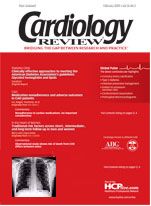Publication
Article
Cardiology Review® Online
Preventing stroke after acute MI Richard M. Steingart, MD
Stroke is a devastating complica-tion of myocardial infarction (MI), whether it occurs in the natural
progression of the disease or accompanying an iatrogenic intervention (catheter, surgical, or drug based). What is particularly important about this well-done analysis by Burns and Spencer (page 34) for the Worcester Heart Attack Study is the dramatic increase in the incidence of stroke in the most recently studied time intervals, rising from 1% at the end of the 1980s to 3% in 1999. In multivariate analyses, advancing age and atrial fibrillation were associated with the likelihood of a stroke after MI. A trend toward increased rates of stroke was seen in women and patients with anterior wall MI.
Post-MI strokes are not a trivial consideration; they portend an ominous prognosis. In-hospital death was significantly more likely in acute MI patients with stroke than in those without stroke (32.6% versus 12.8%; P < .001). After advanced age and cardiogenic shock, multivariate-adjusted regression analysis identified stroke as the most potent predictor of in-hospital death (odds ratio, 4.26). Apart from death, no mention is made of the high physical, psychological, and financial costs of stroke.
Why is the stroke rate on the rise? It is irresistible to speculate. If the patients in this analysis are representative of the broader MI population, one explanation may be that these patients are getting older. Maybe more patients are surviving their infarctions long enough to have another vascular complication. Perhaps they are surviving with paroxysmal or sustained atrial fibrillation, or with clots in the ventricle. It is noteworthy that fibrinolysis, cardiac catheterization, percutaneous coronary intervention, and coronary artery bypass graft surgery did not have a statistically significant association with acute stroke in the overall population. The authors do note that coronary artery bypass grafting was associated with higher stroke rates in the elderly. Taken together, these data suggest that patients under-going these therapeutic procedures soon after infarction were carefully screened so as to lower the stroke risk1 (which was more successfully accomplished in younger than in older patients). Alternatively, if stroke did not complicate the procedure itself, the effects of such interventions could have had a protective effect against stroke.
Why do strokes accompany acute MI? Hemodynamic instability, thromboembolism (atrial, ventricular, or vascular sources), and atherosclerotic plaque instability precipitated by mechanical forces, inflammation, platelet activation, and hypercoagulability have all been implicated. For the relatively few iatrogenic strokes observed in this registry, physical trauma and the effects of anticoagulant and antiplatelet agents are also contributors.
Burns and Spencer include the case report of an 88-year-old woman presenting with the typically atypical clinical syndrome of acute MI in the elderly. She was treated with a thrombolytic agent. Although the symptom-to-needle time was not given, it is usually longer in the elderly than in younger patients. She then went on to have “rescue” angioplasty for her large inferior infarct, having a stroke on hospital day 6 and worsening heart failure on day 14, before dying on day 15. The authors conclude that identification and treatment of modifiable risk factors for stroke following MI is indicated. Based on their univariate analyses, potentially modifiable risk factors would include atrial fi-brillation, prior heart failure, and lack of aspirin therapy. Although HMG-CoA reductase inhibitors (statins) were not included as a variable in the current study, the authors suggest that lack of such therapy after MI could also be a risk factor for stroke. It is not clear whether the woman in their case report had any modifiable risk factors for postinfarction stroke or how effective such interventions would be. She certainly received aggressive and seemingly logical, appropriate therapy. But due to minimal representation of the elderly (particularly the very elderly) in clinical trials of MI, we are all flying without a compass. In the final 2 weeks of her life, this 88-year-old woman was hospitalized in two institutions, received thrombolysis, diagnostic cardiac catheterization, percutaneous transluminal coronary angioplasty with three stents, temporary and permanent pacing, carotid duplex scanning, and a computed tomography scan of the brain (a partial list of procedures and treatments I’m sure). That’s a strong argument for inclusion of the elderly in future registries and clinical trials of MI.2
Conclusion
Stroke is a devastating complication of acute MI. These data support the use of aspirin for all qualifying patients, and full-dose anticoagulation for those with atrial fibrillation. But as the barriers to enrollment of the elderly in clinical trials fall, more comprehensive, evidence-based conclusions will surely follow. n
